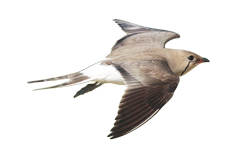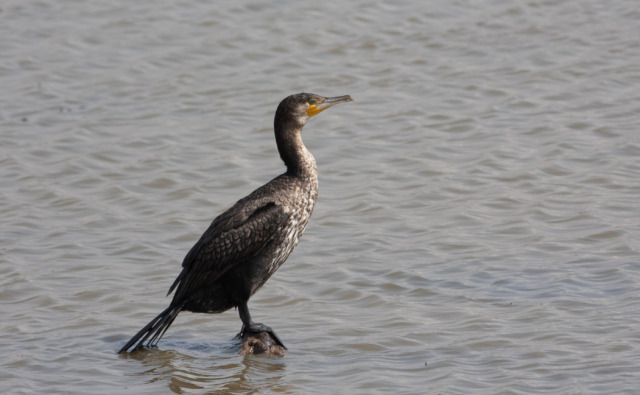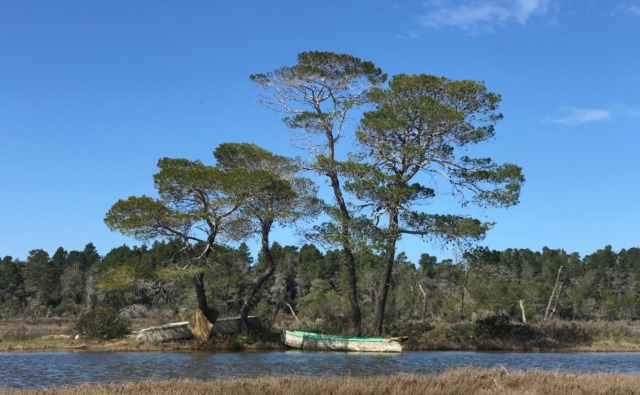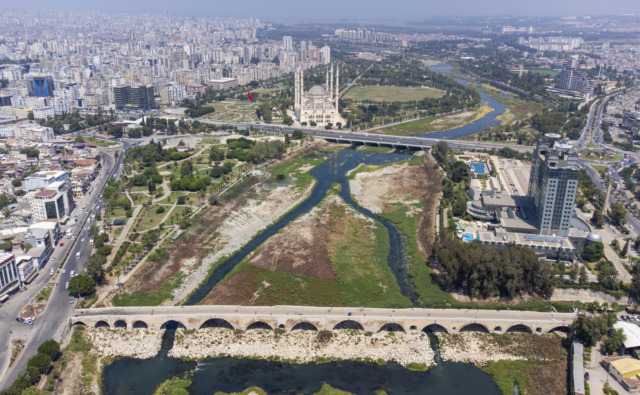Objectives
This project helped to further research and conservation activities on two pelican species (the Dalmatian Pelican (Pelecanus crispus) and the White Pelican (Pelecanus onocrotalus)), distributed in several distinct populations in south-eastern Europe, central Asia, and the Middle East, as well as Sub-Saharan Africa for the White Pelican. The forty years of research were conducted mainly in the Balkans (Greece, Montenegro, Turkey, Romania, Bulgaria, and Albania), but also sometimes outside the Mediterranean Basin, as in the Ukraine.
Actions and methodology
The two species of pelicans concerned have had to respond to major anthropogenic threats, particularly in the Balkans, which have resulted in a low number of nesting colonies and a long-term decline in their populations. In addition, inter-colony exchanges were generally very low, which made it essential to improve the demographic dynamics of each species and to increase their numbers.
To offset these issues, this project consisted in:
- Creating artificial nesting islets that have enabled new colonies to be established (as on Lake Kerkini in Greece),
- Protecting the nesting colonies that are very sensitive to disturbances,
- Maintaining permanent surveillance to limit local threats of human origin, both direct and indirect, including power lines and disturbances by local fishers,
- Educating the local stakeholders (fishers and hunters) who may disturb the pelicans,
- Acquiring scientific knowledge through monitoring of individual birds,
- Creating a group of international experts that work actively on these species.
The Tour du Valat was actively engaged throughout the life of this programme, having coordinated the IUCN Pelican Specialist Group in Europe for many years, working continuously with local partners in each country, particularly for the monitoring of colonies for which it set up protocols for ringing the birds, and monitoring and reading the rings.
Results
Project results were excellent, with an overall increase in the populations of the two species in the countries concerned, as well as a significant decrease in the anthropogenic threats.
The Tour du Valat was awarded the Botiaux-Dulac prize in 2013 to acknowledge its work aiming to protect and conserve threatened wildlife species (read more).
The conservation measures implemented have increased the pelican populations, particularly in Greece with a population of Dalmatian Pelicans on Lake Prespa that has benefited the entire region. Likewise, in 2017 the IUCN status for Dalmatian Pelicans was upgraded from vulnerable to near-threatened).
Future prospects
Following these excellent results, the Tour du Valat finalised its research programme on these two species. It is currently providing support based on its scientific expertise to the project conducted by Noé Conservation in Greece, Albania, and Montenegro (read more).
Team
- Alain Crivelli (1978-2015)
- Jocelyn Champagnon (since 2015)
Technical and financial partners
Armenian Society for the Protection of Birds (Armenia), Skadar Lake National Park (Montenegro), Karavasta Lagoon Nature Reserve (Albania), Society for the Protection of Prespa (Greece), Srebarna Nature Reserve et Le Balkan International (Bulgaria), Danube Delta Nature Reserve (Romania), Izmir Ege University (Turkey), Noé Conservation et the European Union.
Bibliography
Catsadorakis G., Crivelli A.J. 2001. Nesting Habitat Characteristics and Breeding Performance of Dalmatian Pelicans in Lake Mikri Prespa, NW Greece. Waterbirds: The International Journal of Waterbird Biology 24:386. doi: 10.2307/1522069
Catsadorakis G., Malakou M., Crivelli A.J. 1996. The Effects of the 1989/1990 Drought on the Colonial Waterbirds Nesting at Lake Mikri Prespa, Greece, with Special Emphasis on Pelicans. Colonial Waterbirds 19:207. doi: 10.2307/1521964
Catsadorakis G., Onmus¸ O., Bugariu S., Gül O., Hatzilacou D., Hatzofe O., Malakou M., Michev T., Naziridis T., Nikolaou H., Rudenko A., Saveljic D., Shumka S., Sıkı M., Crivelli A. 2015. Current status of the Dalmatian pelican and the great white pelican populations of the BlackSea/Mediterranean flyway. Endangered Species Research 27:119–130. doi: 10.3354/esr00659
Crivelli A., Vizi O. 1981. The Dalmatian pelican, Pelecanus crispus Bruch 1832, a recently world-endangered bird species. Biological Conservation 20:297–310. doi: 10.1016/0006-3207(81)90016-1
Crivelli A.J. 1987. The ecology and behaviour of the Dalmatian Pelican, Pelecanus crispus Bruch, a world-endangered species. Final report to the Commission of the European communities 94.
Crivelli A.J. 1994. Why do Great White Pelican chicks die suddenly on Arel island, Banc d’Arguin, in Mauritania? Revue d’Ecologie (La Terre et la Vie) 49:321-330
Crivelli A.J. 1996. Action plan for the Dalmatian pelican (Pelecanus crispus) in Europe. Globally Threatened Birds in Europe: Action Plans Council of Europe Publishing, Strasbourg:53–66.
Crivelli A.J., Hatzilacou D., Catsadorakis G. 2008. The breeding biology of the Dalmatian Pelican Pelecanus crispus. Ibis 140:472–481. doi: 10.1111/j.1474-919X.1998.tb04609.x
Crivelli A.J., Jerrentrup H., Mitchev T. 1988. Electric power lines: a cause of mortality in Pelecanus crispus Bruch, a world endangered bird species, in Porto-Lago, Greece. Colonial Waterbirds:301–305.
Crivelli A.J., Leshem Y., Mitchev T., Jerrentrup H. 1991a. Where do Palaearctic Great White Pelicans (Pelecanus onocrotalus) presently overwinter? Revue d’Ecologie (La Terre et la Vie) 46:145–171.
Crivelli, A.J., Mitchev T., Catsadorakis G. & V. Pomakov 1991b. Preliminary results on the wintering of Dalmatian pelican, Pelecanus crispus, in Turkey. Zoology in the Middle East, 5, 11-20.
Crivelli A.J., Marsili L., Focardi S., Renzoni A. 1999. Organochlorine Compounds in Pelicans ( Pelecanus crispus and Pelecanus onocrotalus) Nesting at Lake Mikri Prespa, North Western Greece. Bulletin of Environmental Contamination and Toxicology 62:383–389. doi: 10.1007/s001289900886
Crivelli A.J. V.G. Krivenko & V.G. Vinogradov 1994. Pelicans in former USSR, 26 manuscripts). International Waterfowl Research Bureau Special Publication N° 27, 1-151.
Crivelli A.J. ,Catsadorakis G., Jerrentrup H., Hatzilacos D. & T. Mitchev 1991. Conservation and management of pelicans nesting in the Palearctic. In : ” Conservation of Migratory birds “, T. Salathe (ed.), ICBP Technical Publication n° 12, 137-152 .
Crivelli A.J. 1980. The importance of Greece for the conservation of two species of pelicans : Pelecanus onocrotalus and Pelecanus crispus . Nature-Newsletter (Greece), 23-24, 36-39.
Crivelli A.J. 1984. European Pelican populations and their conservation. Proceedings of the EEC Contact Group Meeting, Conservation of Birds, Durham, England, 1983, 123-127.
Crivelli A.J. 1992. Conservation et gestion des pélicans nicheurs dans la région paléarctique. In: France-Roumanie Environnment et cadre de vie, G. Carasso & N. Dodille (eds). L’Harmattan, Paris, France, pp 161-167.
Crivelli A.J., Catsadorakis G., Hatzilacou D. & T. Nazirides1997. Pelecanus crispus Dalmatian pelican. BWP Update 1, 149-153.
Crivelli A.J. Catsadorakis G. & T. Nazirides 1997. Pelecanus onocrotalus White pelican. BWP Update 1, 144-148.
Crivelli A.J., Catsadorakis G., Hatzilacou, D., Hulea D., Malakou, M., Marinov M., Nazirides T., Peja N., Sarigul & M. Siki 2000. Status and population development of Great white pelican Pelecanus onocrotalus and Dalmatian pelican P. crispus breeding in the Palearctic. In : Monitoring and conservation of birds, mammals and sea turtles of the Mediterranean and Black Seas (P. Yésou & J. Sultana, eds). La Vallette, Malta, pp 38-45.
Crivelli, A.J. & R.W. Schreiber 1984. Status of Pelecanidae. Biological Conservation, 30, 147-156.
Crivelli, A.J., S. Focardi, C. Fossi, C. Leonzio, A. Massi & A. Renzoni 1989. Trace elements and chlorinated hydrocarbons in eggs of Pelecanus crispus a world endangered bird species nesting at Lake Mikri Prespa, north-western Greece. Environmental Pollution, 61, 235-247.
Dentressangle F., Poizat G., Crivelli A.J. 2008. Feeding frequency influences crèching age in the Dalmatian pelican, Pelecanus crispus. Journal of Ornithology 149:431–437. doi: 10.1007/s10336-008-0275-0
Doxa A., Robert A., Crivelli A., Catsadorakis G., Naziridis T., Nikolaou H., Jiguet F., Theodorou K. 2012. Shifts in breeding phenology as a response to population size and climatic change: A comparison between short- and long-distance migrant species. The Auk 129:753–762. doi: 10.1525/auk.2012.11213
Doxa A., Theodorou K., Crivelli A.J., Hatzilacou D., Catsadorakis G., Malakou M., Nazirides T., Robert A. 2012. Spatially correlated environmental factors drive synchronisation in populations of the Dalmatian Pelican. Population Ecology 54:499–507. doi: 10.1007/s10144-012-0330-9
Doxa A., Theodorou K., Hatzilacou D., Crivelli A., Robert A. 2010. Joint effects of inverse density-dependence and extreme environmental variation on the viability of a social bird species. Ecoscience 17:203–215. doi: 10.2980/17-2-3304
Izhaki I., Shmueli M., Arad Z., Steinberg Y., Crivelli A. 2002. Satellite Tracking of Migratory and Ranging Behavior of Immature Great White Pelicans. Waterbirds 25:295–304. doi: 10.1675/1524-4695(2002)025[0295:STOMAR]2.0.CO;2
Michev T. & A.J. Crivelli 1998. Les effectifs reproducteurs du pélican frisé (Pelecanus crispus Bruch, 1832) dans la réserve de Biosphère de Srebarna, 1955-1998. Branta, 3, 6-9.
Onmus O. et al. 2011. Status and development of the population of the globally threatened Dalmatian pelican, Pelecanus crispus, in Turkey. Zoology in the Middle East 54, 3-17.
Peja, N., G. Sarigul, M. Siki & A.J. Crivelli 1996. The Dalmatian pelican, Pelecanus crispus, nesting in Mediterranean lagoons in Albania and Turkey. Colonial Waterbirds, 19 (Special Publication 1), 184-189.
Pyrovetsi, M. & A.J. Crivelli 1988. Habitat use by water-birds in Prespa National Park, Greece. Biological Conservation, 45, 135-153.
Rachel Guénon. 2014. Se reproduire ou ne pas se reproduire : dilemme de vie chez le Pélican frisé (Pelecanus crispus). [Master 2]: Université Montpellier II Sciences et Techniques du Languedoc.
Schogolev, I., Rudenko, A. & A.J. Crivelli 2005. Status of pelicans and cormorants on the northern Black Sea. Bird Conservation International, 15, 63-71.
Shmueli M., Arad Z., Izhaki I., Crivelli A. 2000. The energetic demand of the Great White Pelican during migration in Israel and its implication to the conflict between fish industry and pelicans. Ostrich 71:1–1. doi: 10.1080/00306525.2000.9639853



